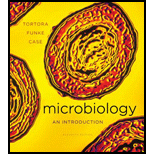
Microbiology: An Introduction
11th Edition
ISBN: 9780321733603
Author: Gerard J. Tortora, Berdell R. Funke, Christine L. Case
Publisher: Benjamin Cummings
expand_more
expand_more
format_list_bulleted
Concept explainers
Textbook Question
Chapter 4, Problem 4A
In 1985, a 0.5-mm cell was discovered in surgeonfish and named Epulopiscium fishelsoni (see Figure 11-14 page 308). It was presumed to be a protozoan. In 1993, researchers determined that Epulopiscium was actually a gram-positive bacterium. Why do you suppose this organism was initially identified as a protozoan? What evidence would change the classification to bacterium?
Expert Solution & Answer
Want to see the full answer?
Check out a sample textbook solution
Students have asked these similar questions
Describe a method to document the diffusion path and gradient of Sonic Hedgehog through the chicken embryo. If modifying the protein, what is one thing you have to consider in regards to maintaining the protein’s function?
The following table is from Kumar et. al. Highly Selective Dopamine D3 Receptor (DR) Antagonists and Partial Agonists Based on Eticlopride and the D3R Crystal Structure: New Leads for Opioid Dependence Treatment. J. Med Chem 2016.
The following figure is from Caterina et al. The capsaicin receptor: a heat activated ion channel in the
pain pathway. Nature, 1997. Black boxes indicate capsaicin, white circles indicate resinferatoxin.
You are a chef in a fancy new science-themed restaurant. You have a recipe that calls for 1 teaspoon of resinferatoxin, but you feel uncomfortable serving foods with "toxins" in them. How much capsaicin could you substitute instead?
Chapter 4 Solutions
Microbiology: An Introduction
Ch. 4 - DRAW IT Diagram each of the following flagellar...Ch. 4 - Endospore formation is called (a) _____. It is...Ch. 4 - DRAW IT Draw the bacterial shapes listed in (a),...Ch. 4 - Match the structures in column A to their...Ch. 4 - Why is an endospore called a resting structure? Of...Ch. 4 - Compare and contrast the following a. simple...Ch. 4 - Prob. 7RCh. 4 - Starch is readily metabolized by many cells, but a...Ch. 4 - Match the characteristics of eukaryotic cells in...Ch. 4 - NAME IT What group of microbes is characterized by...
Ch. 4 - How can prokaryotic cells be smaller than...Ch. 4 - The smallest eukaryotic cell is the motile alga...Ch. 4 - Two types of prokaryotic cells have been...Ch. 4 - In 1985, a 0.5-mm cell was discovered in...Ch. 4 - When E. coli cells are exposed to a hypertonic...Ch. 4 - Which of the following is not a distinguishing...Ch. 4 - Which statement best describes what happens when a...Ch. 4 - Which statement best describes what happens when a...Ch. 4 - Which statement best describes what happens when a...Ch. 4 - Which of the following statements best describes...Ch. 4 - Which of the following is false about fimbriae? a....Ch. 4 - Which of the following pairs is mismatched? a....Ch. 4 - Which of the following pairs is mismatched? a....Ch. 4 - You have isolated a motile, gram-positive cell...Ch. 4 - The antibiotic amphothericin B disrupts plasma...Ch. 4 - Clostridium botulinum is a strict anaerobe; that...Ch. 4 - A South San Francisco child enjoyed bath time at...Ch. 4 - Live cultures of Bacillus thuringiensis (Dipel)...
Knowledge Booster
Learn more about
Need a deep-dive on the concept behind this application? Look no further. Learn more about this topic, biology and related others by exploring similar questions and additional content below.Similar questions
- What protein is necessary for packaging acetylcholine into synaptic vesicles?arrow_forward1. Match each vocabulary term to its best descriptor A. affinity B. efficacy C. inert D. mimic E. how drugs move through body F. how drugs bind Kd Bmax Agonist Antagonist Pharmacokinetics Pharmacodynamicsarrow_forward50 mg dose of a drug is given orally to a patient. The bioavailability of the drug is 0.2. What is the volume of distribution of the drug if the plasma concentration is 1 mg/L? Be sure to provide units.arrow_forward
- Determine Kd and Bmax from the following Scatchard plot. Make sure to include units.arrow_forwardChoose a catecholamine neurotransmitter and describe/draw the components of the synapse important for its signaling including synthesis, packaging into vesicles, receptors, transporters/degradative enzymes. Describe 2 drugs that can act on this system.arrow_forwardThe following figure is from Caterina et al. The capsaicin receptor: a heat activated ion channel in the pain pathway. Nature, 1997. Black boxes indicate capsaicin, white circles indicate resinferatoxin. a) Which has a higher potency? b) Which is has a higher efficacy? c) What is the approximate Kd of capsaicin in uM? (you can round to the nearest power of 10)arrow_forward
arrow_back_ios
SEE MORE QUESTIONS
arrow_forward_ios
Recommended textbooks for you
 Concepts of BiologyBiologyISBN:9781938168116Author:Samantha Fowler, Rebecca Roush, James WisePublisher:OpenStax CollegeBasic Clinical Lab Competencies for Respiratory C...NursingISBN:9781285244662Author:WhitePublisher:Cengage
Concepts of BiologyBiologyISBN:9781938168116Author:Samantha Fowler, Rebecca Roush, James WisePublisher:OpenStax CollegeBasic Clinical Lab Competencies for Respiratory C...NursingISBN:9781285244662Author:WhitePublisher:Cengage Biology Today and Tomorrow without Physiology (Mi...BiologyISBN:9781305117396Author:Cecie Starr, Christine Evers, Lisa StarrPublisher:Cengage Learning
Biology Today and Tomorrow without Physiology (Mi...BiologyISBN:9781305117396Author:Cecie Starr, Christine Evers, Lisa StarrPublisher:Cengage Learning Biology (MindTap Course List)BiologyISBN:9781337392938Author:Eldra Solomon, Charles Martin, Diana W. Martin, Linda R. BergPublisher:Cengage Learning
Biology (MindTap Course List)BiologyISBN:9781337392938Author:Eldra Solomon, Charles Martin, Diana W. Martin, Linda R. BergPublisher:Cengage Learning Comprehensive Medical Assisting: Administrative a...NursingISBN:9781305964792Author:Wilburta Q. Lindh, Carol D. Tamparo, Barbara M. Dahl, Julie Morris, Cindy CorreaPublisher:Cengage Learning
Comprehensive Medical Assisting: Administrative a...NursingISBN:9781305964792Author:Wilburta Q. Lindh, Carol D. Tamparo, Barbara M. Dahl, Julie Morris, Cindy CorreaPublisher:Cengage Learning


Concepts of Biology
Biology
ISBN:9781938168116
Author:Samantha Fowler, Rebecca Roush, James Wise
Publisher:OpenStax College

Basic Clinical Lab Competencies for Respiratory C...
Nursing
ISBN:9781285244662
Author:White
Publisher:Cengage

Biology Today and Tomorrow without Physiology (Mi...
Biology
ISBN:9781305117396
Author:Cecie Starr, Christine Evers, Lisa Starr
Publisher:Cengage Learning

Biology (MindTap Course List)
Biology
ISBN:9781337392938
Author:Eldra Solomon, Charles Martin, Diana W. Martin, Linda R. Berg
Publisher:Cengage Learning

Comprehensive Medical Assisting: Administrative a...
Nursing
ISBN:9781305964792
Author:Wilburta Q. Lindh, Carol D. Tamparo, Barbara M. Dahl, Julie Morris, Cindy Correa
Publisher:Cengage Learning
Bacterial Endospore Formation -Biology Pundit; Author: Biology Pundit;https://www.youtube.com/watch?v=6_sinRhE8zA;License: Standard YouTube License, CC-BY
Taxonomy of Bacteria: Identification and Classification; Author: Professor Dave Explains;https://www.youtube.com/watch?v=8IJRzcPC9wg;License: Standard YouTube License, CC-BY